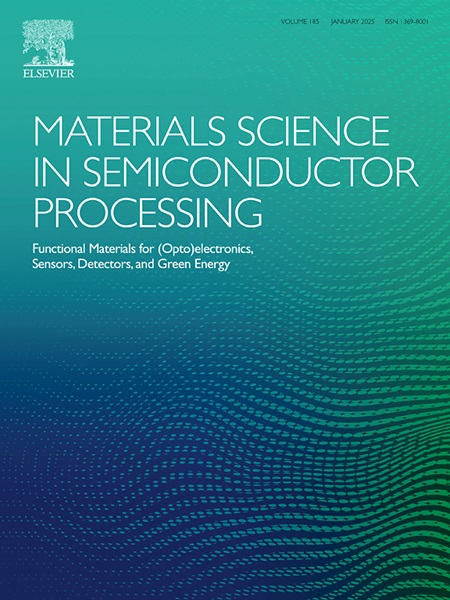Modulating the structural framework with electron-withdrawing groups and studying their effects on charge mobility in a new series of D-A-D based organic semiconductors
IF 4.2
3区 工程技术
Q2 ENGINEERING, ELECTRICAL & ELECTRONIC
引用次数: 0
Abstract
A systematic computational study was conducted on a new series of donor-acceptor-donor (D-A-D) architecture molecules, featuring bithiazolimide as the acceptor (A) and thiophene as the donor (D), to evaluate the effect of electron-withdrawing substituents on their charge mobility. Density functional theory (DFT) and time-dependent DFT were used to analyze HOMO/LUMO stability, electron affinity (EA), ionization potential (IP), reorganization energy (λ), charge mobility (μ), absorption spectra, and density of states (DOS), revealing the impact of steric and electronic properties on charge transport in the D-A-D framework. The observed trend of variation of the ionization potential and electron affinity suggests increasing charge transfer behaviour with increasing substitution constant. The study reveals that electron mobility is directly proportional to the strength of the electron-withdrawing substituent. Molecules containing -F, -Cl, -CSCH3, -COCH3 and -CF3 exhibited higher electron mobility pointing towards their dominating n-type character, whereas molecules containing -CN and -NO2 showed balanced electron and hole mobilities, suggesting an ambipolar nature. In contrast molecule 4, with a -CSCH3 substituent, demonstrates the highest electron mobility and the smallest HOMO-LUMO gap, making it particularly promising for n-type organic semiconductor applications. The high electron mobility of molecule 4 is further supported by non-covalent interaction (NCI) analysis, which shows S⋯S interactions within the thiophene ring and electron-withdrawing substituents present in the donor moiety. Further, electrostatic potential (ESP) and transition density matrix (TDM) analyses support effective charge separation within these molecules, suggesting an optimized D-A-D system with strong electron-withdrawing substituents and minimal steric hindrance. These findings highlight the potential of these systems in developing high-mobility n-type organic semiconductors, contributing valuable insights for advancing organic electronic devices.

用吸电子基团调制新型D-A-D基有机半导体的结构框架及其对电荷迁移率的影响
以双噻唑酰亚胺为受体(A),噻吩为给体(D),对一系列新的给体-受体-给体(D-A-D)结构分子进行了系统的计算研究,以评价吸电子取代基对其电荷迁移率的影响。利用密度泛函理论(DFT)和时变DFT分析了HOMO/LUMO的稳定性、电子亲和度(EA)、电离势(IP)、重组能(λ)、电荷迁移率(μ)、吸收光谱和态密度(DOS),揭示了空间和电子性质对D-A-D框架中电荷输运的影响。观察到的电离势和电子亲和的变化趋势表明,电荷转移行为随着取代常数的增加而增加。研究表明,电子迁移率与吸电子取代基的强度成正比。含有-F、-Cl、-CSCH3、-COCH3和-CF3的分子具有较高的电子迁移率,表明其主要的n型特征,而含有-CN和-NO2的分子具有平衡的电子和空穴迁移率,表明其双极性性质。相反,分子4具有-CSCH3取代基,表现出最高的电子迁移率和最小的HOMO-LUMO间隙,使其在n型有机半导体应用中特别有前景。分子4的高电子迁移率进一步得到了非共价相互作用(NCI)分析的支持,该分析显示噻吩环内的S⋯S相互作用和供体部分中存在的吸电子取代基。此外,静电电位(ESP)和跃迁密度矩阵(TDM)分析支持这些分子内有效的电荷分离,表明优化的D-A-D体系具有强吸电子取代基和最小的位阻。这些发现突出了这些系统在开发高迁移率n型有机半导体方面的潜力,为推进有机电子器件的发展提供了宝贵的见解。
本文章由计算机程序翻译,如有差异,请以英文原文为准。
求助全文
约1分钟内获得全文
求助全文
来源期刊

Materials Science in Semiconductor Processing
工程技术-材料科学:综合
CiteScore
8.00
自引率
4.90%
发文量
780
审稿时长
42 days
期刊介绍:
Materials Science in Semiconductor Processing provides a unique forum for the discussion of novel processing, applications and theoretical studies of functional materials and devices for (opto)electronics, sensors, detectors, biotechnology and green energy.
Each issue will aim to provide a snapshot of current insights, new achievements, breakthroughs and future trends in such diverse fields as microelectronics, energy conversion and storage, communications, biotechnology, (photo)catalysis, nano- and thin-film technology, hybrid and composite materials, chemical processing, vapor-phase deposition, device fabrication, and modelling, which are the backbone of advanced semiconductor processing and applications.
Coverage will include: advanced lithography for submicron devices; etching and related topics; ion implantation; damage evolution and related issues; plasma and thermal CVD; rapid thermal processing; advanced metallization and interconnect schemes; thin dielectric layers, oxidation; sol-gel processing; chemical bath and (electro)chemical deposition; compound semiconductor processing; new non-oxide materials and their applications; (macro)molecular and hybrid materials; molecular dynamics, ab-initio methods, Monte Carlo, etc.; new materials and processes for discrete and integrated circuits; magnetic materials and spintronics; heterostructures and quantum devices; engineering of the electrical and optical properties of semiconductors; crystal growth mechanisms; reliability, defect density, intrinsic impurities and defects.
 求助内容:
求助内容: 应助结果提醒方式:
应助结果提醒方式:


